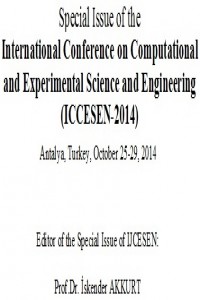Simulation of Electrical Stimulation of Layered Retina with Bipolar Electrode Configuration and Temperature Change on the Retina
Abstract
Visual perception may be completely lost due to some degenerative retinal diseases in time. Degenerative retinal diseases, such as Age Related Macular Degeneration (AMD) and Retinitis Pigmentosa (RP), are damaged to the photoreceptor layer of the retina, but visual cortex of the brain and half of the inner structures of the retina remain intact. Visual prosthesis systems are based on electrically stimulation of remaining nerve cells by placing stimulation electrode array and necessary electronics on the retinal tissue. In the first part of this study, two-dimensional retina model, which use bipolar electrode configuration system in which stimulation current is passed between two electrodes, thus an activation region is created, is developed. Solution is made using Finite Element Analysis (FEA). Electric field distribution and current density are investigated depending on the potential difference. It is showed that maximum electric field intensity increases with the rise of potential difference, moreover, electric field enlarges over the retina tissue. Current density is much higher at the positions where edges of the stimulation electrodes are. This means that nerve cells in deeper regions could be stimulated. Then, second part includes the investigation of temperature change on the tissue induced by power dissipation of the electronics and stimulation electrode arrays. Results showed that temperature change has an increasing trend with the rise of power dissipated. Change in the temperature near the electrode and activation region is more sensitive, so temperature change diminishes in the regions away from heat source.
Keywords
Bipolar electrode epiretinal implants electrical stimulation finite element analysis visual prosthesis
References
- Chang, “Finite element analysis of hepatic radiofrequency ablation probes using temperature- dependent electrical conductivity,” Biomed. Eng. Online, 2-12, 2003.
- S. Tungjitusolmun, E. J. Woo and H. Cao, “Finite element analyses of uniform current density electrodes for radio-frequency cardiac ablation,” IEEE Trans. Biomed. Eng., 47 32–40, 2000.
- B. Bennetts, M. L. Roberts, A. H. Bretag and G. Y. Rychkov, “Temperature dependence of human muscle ClC-1 chloride channel,” J. Physiol., 535 83–93, 2001.
- T. M. Seese, H. Harasaki, G. M. Saidel, and C. R. Davies, “Characterization of tissue morphology, angiogenesis, and temperature in the adaptive response of muscle tissue in chronic heating,” Lab. Investigation, vol. 78, pp. 1553–1562, 1998.
- K. Gosalia, J.Weiland, M. Humayun, and G. Lazzi, “Thermal elevation in the human eye and head due to the operation of a retinal prosthesis,” IEEE Trans. Biomed. Eng., vol. 51, no. 8, pp. 1469–1477, 2004.
- C. M. Collins, M. B. Smith, and R. Turner, “Model of local temperature changes in brain upon functional activation,” J Appl. Physiol., vol. 97, pp. 2051–2055, 2004.
- C. W. Connor and K. Hynynen, “Patterns of thermal deposition in the skull during transcranial focused ultrasound surgery,” IEEE Trans. Biomed. Eng., vol. 51, no. 10, pp. 1693–1706, Oct. 2004.
Abstract
References
- Chang, “Finite element analysis of hepatic radiofrequency ablation probes using temperature- dependent electrical conductivity,” Biomed. Eng. Online, 2-12, 2003.
- S. Tungjitusolmun, E. J. Woo and H. Cao, “Finite element analyses of uniform current density electrodes for radio-frequency cardiac ablation,” IEEE Trans. Biomed. Eng., 47 32–40, 2000.
- B. Bennetts, M. L. Roberts, A. H. Bretag and G. Y. Rychkov, “Temperature dependence of human muscle ClC-1 chloride channel,” J. Physiol., 535 83–93, 2001.
- T. M. Seese, H. Harasaki, G. M. Saidel, and C. R. Davies, “Characterization of tissue morphology, angiogenesis, and temperature in the adaptive response of muscle tissue in chronic heating,” Lab. Investigation, vol. 78, pp. 1553–1562, 1998.
- K. Gosalia, J.Weiland, M. Humayun, and G. Lazzi, “Thermal elevation in the human eye and head due to the operation of a retinal prosthesis,” IEEE Trans. Biomed. Eng., vol. 51, no. 8, pp. 1469–1477, 2004.
- C. M. Collins, M. B. Smith, and R. Turner, “Model of local temperature changes in brain upon functional activation,” J Appl. Physiol., vol. 97, pp. 2051–2055, 2004.
- C. W. Connor and K. Hynynen, “Patterns of thermal deposition in the skull during transcranial focused ultrasound surgery,” IEEE Trans. Biomed. Eng., vol. 51, no. 10, pp. 1693–1706, Oct. 2004.
Details
| Primary Language | English |
|---|---|
| Journal Section | Research Articles |
| Authors | |
| Publication Date | September 26, 2015 |
| Submission Date | September 26, 2015 |
| Published in Issue | Year 2015 Volume: 1 Issue: 1 |


